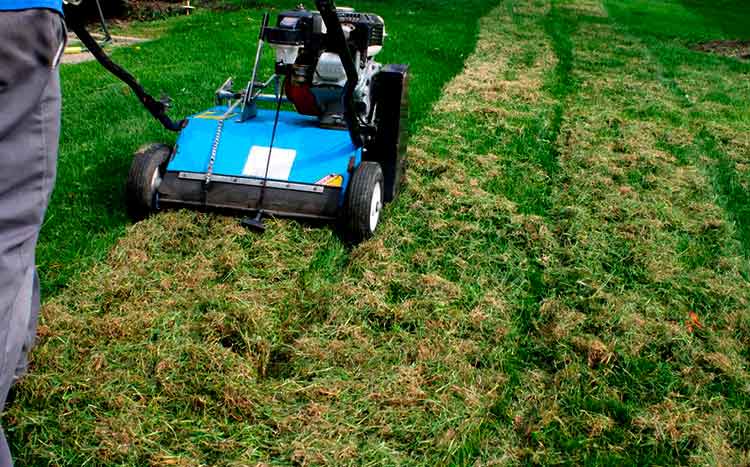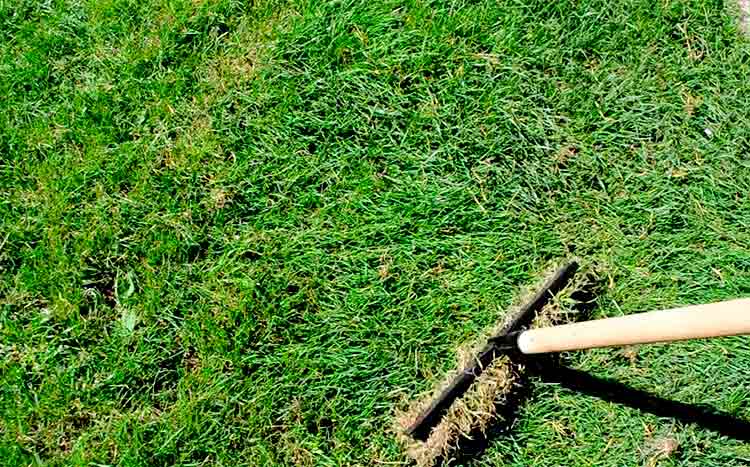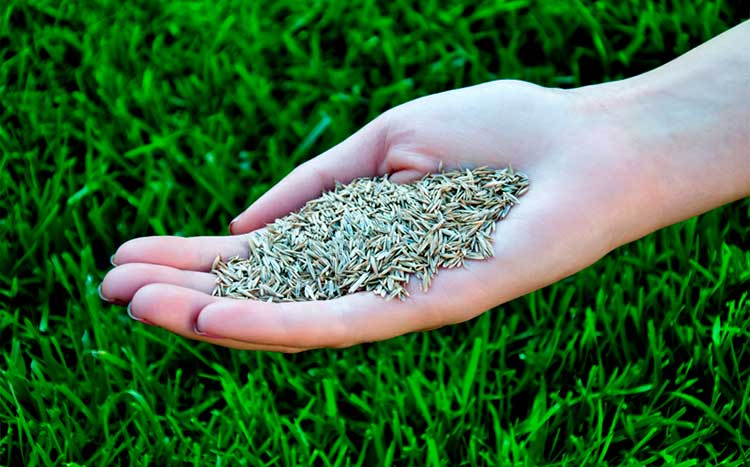Many individuals do not see dethatching as a necessary task for lawn maintenance and often neglect it until it becomes too late.
Lawn dethatching is an important lawn maintenance activity and a by-product of thick lush lawn. A very poor thin lawn will not have thatch buildup, but a lawn that is healthy will eventually build up thatch that needs to be removed periodically.
Removing thatch buildup known as dethatching allows water, nutrients, and oxygen to penetrate the soil and roots for better long-term lawn health.
What we cover
ToggleDoes Dethatching Hurt Your Lawn?

Dethatching is done to improve the overall health of your grass. If done properly, your grass will have better access to water, nutrients, oxygen, and the sun for better growth.
While dethatching, the machine or rake will selectively slice through thick thatch and also lift unwanted plant material such as young weeds, fallen leaves, and dead roots. However, healthy young grass below half an inch in thickness will be left intact to flourish.
Dethatching has the following direct benefits for your lawn:
Dethatching Improves Drainage
Dethatching essentially creates more space between grass thus allowing water to seep into the soil. You can also improve water absorption further by aerating your lawn immediately after removing the thatch.
Dethatching Allows for Better Nutrient Absorption and Sun Penetration
Give your grass a better chance of absorbing nutrients from liquid fertilizers and mulch by getting rid of thick thatch. This is because too much thatch forms a dense cover that does not decompose and also blocks nutrients from seeping into the soil. You will have a harder time applying liquid fertilizer to a lawn that has thick thatch as most of it will remain on the surface and evaporate.
At the same time, dethatching will allow more sun rays and oxygen to hit the base of healthy young grass thus aiding nutrient breakdown and better health. Too much thatch makes it harder for young plant shoots to grow.
Dethatching Gets Rid of Young Weeds
While dethatching, you will also be able to slice and uproot young weeds that are embedded in the thatch. This means you won’t have to spend more money in the future to remove weeds using chemicals. For instance, you can get rid of young clover using a dethatching rake or dethatching machine.
Dethatching Makes Your Lawn Safer for Pets and Kids
Too much thatch can act as a cover for dangerous objects that can hurt pets and young kids. At the same time, thick thatch is generally unsafe as it tends to entangle and trip people walking or running on it. It’s always good to keep the thatch to a minimum so as to make it safe and more comfortable for foot traffic.
Dethatching Gets Rid of Pests and Mosquitoes
Thick and dense thatch can act as a breeding ground for pests and disease-carrying insects such as mosquitoes. This is especially bad if the thatch is also causing waterlogging as insects tend to thrive in such environments. Keeping thatch to a minimum will eliminate the pests and their breeding ground.
Dethatching Improves Curb Appeal
While you might not appreciate the effects immediately, dethatching will improve the appearance of your lawn. The grass will look greener, fresh, and more uniform after a few days especially if you dethatch in the growing season. The brown thatch at the base of your lawn grass will disappear too.
There are several other direct and indirect benefits you might get after dethatching your lawn. Dethatching can also be necessary when you want to aerate and hydroseed your lawn to extend its life and appearance.

Is There A Natural Way to dethatch?
You can also try other less intrusive alternatives such as core aeration or hand raking if the thatch is not too thick instead of dethatching. Core aeration involves using a machine to loosen the soil so that water and nutrients can seep through. It does not get rid of excess thatch and should ideally be done after dethatching.
The only natural but more labor-intensive way to prevent thatch formation is to prevent it from accumulating in the first place. Do regular raking, especially after mowing and weed removal. Some types of grass such as ryegrass and fescue also tend to form less thatch and do not require frequent dethatching.
Also, be careful not to over-fertilize as this causes the grass to grown too fast and thick thus forming thatch. It is recommended that you do not use more than eight pounds of nitrogen fertilizer on two thousand square feet of lawn per year to prevent thatch formation. Refer to the guidelines on your fertilizer of choice on the quantities you need to use depending on the type of grass and climate in your location.

How Do I Know When My Lawn Needs Dethatching?
Early signs that your grass needs dethatching are brown dead stems, bad drainage, and unexplained dry patches on the lawn. An increase in the number of insects and other pests on your lawn may also be a sign that your lawn needs dethatching.
Here are some other ways you can determine if you need to dethatch:
Thick Thatch (Above ½ In Diameter)
Thatch that is less than half an inch in diameter is not bad. You will know that you need to dethatch if the thatch has grown thicker than half an inch and appears dense from the surface. You may need to dig a section of your grass and check the thatch layer if you want to be more accurate.
Accumulated Dead Plant Material
If there are too many dead plant materials that you can barely see the healthy grass from above, then you need to dethatch immediately. Too much dead plant material may prevent healthy grass from reaching the sun and nutrients.
Waterlogging
In the rainy season or after sprinkling your lawn, you may be able to tell if the thatch layer beneath the grass has grown too thick if you observe waterlogging. A thick thatch layer prevents water from seeping into the soil.
Spongey, Bouncy Grass
Walking on a lawn that has too much thatch feels like walking on a sponge or thick mattress. While this might seem like a good thing, it could be a sign that the thatch layer below the surface is too thick and has a lot of soft dead plant material that cannot decompose.
Uneven Surface
Signs of thatch buildup could also manifest in the form of uneven patches that are visible from above. You will observe a section of grass that is too tall or dense while other sections have shorter grass.
Physical Appearance
In most cases, the surface appearance of your lawn will be enough to tell you if you need to dethatch or not. Observe the way your grass appears over time and keep an eye out for excess thatch, pests, and dead plant material that is not decomposing.
How Much Does Dethatching Cost?
On average, you should expect to pay a professional contractor around $150 to $240 to detach a standard residential lawn in the United States. However, the amount you pay depends on the size of your lawn, the amount of thatch, and the hourly rate you agree with the company. Hourly rates for dethatching a lawn range between $50 to $65.
Most companies will charge depending on the size of your lawn and the number of hours spent dethatching. The average rates per square foot range between $0.22 to $0.45 although most companies wouldn’t give quotes on single units. Rather, you could be charged between $220 to $450 for every 1000 square feet of lawn.
The table below shows estimates for dethatching services in the United States.
| Lawn Size/ dethatching Pricing | Estimated Price |
|---|---|
| The average price for dethatching | $125 - $250 |
| Lawn dethatching per square foot | $0.2- $0.25 |
| Lawn dethatching per hour | $55 - $65 |
| Dethatching price per ½ acre | $500- $650 |
| Dethatching per 1 acre | $700-$1000 |
Note: The amounts you will be charged depend on specific conditions on your lawn such as ease of access, type of grass and amount of thatch to be removed. Other factors that may influence dethatching costs include the number of workers involved, the type of equipment used, and the time of year.
Costs to rent a verticutter or dethatching rake are in the same range as hiring a professional. You will pay between $50 – $80 per hour to rent a verticutter for DIY dethatching.
How Often Should I Dethatch?
You should ideally dethatch your lawn every year just before the growing season. However, the dethatching schedule and frequency also depend on the type of grass, soil conditions, and other factors on your lawn. For instance, soils with imbalanced PH and nutrient levels tend to have a thatch problem and may require more frequent dethatching.
Can I Dethatch and Aerate at The Same Time?
Dethatching and aerating at the same time is recommended because it doubles the effects. After removing the excess thatch, you can go ahead and aerate your lawn so that you make the soil less compact and allow more water and nutrients to seep into the soil. Aeration and dethatching often go hand in hand as excess thatch usually stresses the soil and causes it to compact.
Should I Overseed After Dethatching?
You can choose to overseed after detaching if it is necessary to plant more grass. Overseeding will help restore dead grass in areas where thatch buildup leads to excessive drying or patchy growth. Have a professional assess the condition of your lawn before you decide to overseed or aerate.
Most of the companies offering dethatching services will also provide aeration and overseeding or hydroseeding services. It’s better to sign an all-inclusive lawn maintenance contract with one company. They will be able to advise you when it is time to mow, dethatch, weed, or aerate your lawn.

How do I stop thatch buildup?
Here are some of the ways to prevent thatch buildup on your lawn:
- Test and correct the soil PH – Ensure that the PH levels in your soil are not causing thatch buildup. Balanced soil PH is crucial for the decomposition of dead plant matter, controlled grass growth, and overall grass health.
- Use the recommended fertilizer for your lawn – Seek advice from a professional if unsure about the type of fertilizer you should be using on your grass.
- Regular mowing and raking – Proper care through mowing and raking will prevent thatch buildup.
What Companies Do Dethatching?
Most landscaping, lawn care, and gardening companies also provide lawn dethatching services. Choose a company with lawn dethatching mentioned as one of the services they offer to clients in your area. Also consider the type of machines they have, experience, testimonials from previous clients, and track record.






